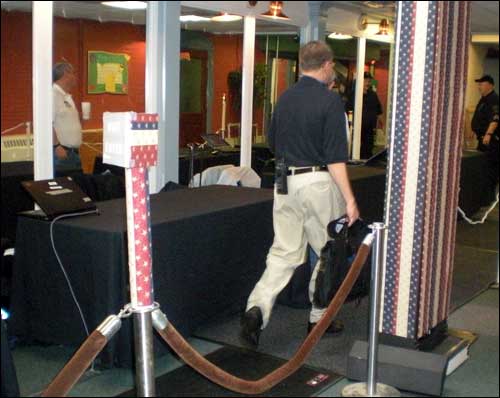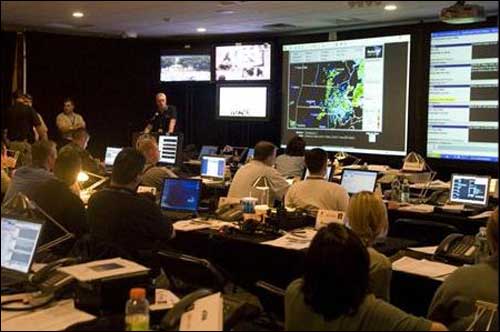Jul 10, 2009On July 3 and 4, when the Boston Pops' Fourth of July concerts took place at the city's Esplanade along the Charles River, 500,000 audience members descended upon the area, as well as 20 federal, state and local agencies to ensure their safety. The annual program, which concludes with a fireworks display on July 4, is managed by nonprofit group Boston 4 Productions (B4), and has become one of the United States' largest Independence Day celebrations. At each event, public safety agencies operate a single command center in a local college's student union building. This year, B4 maintained the security and traffic flow of that unified command center (UCC) using RFID technology. By embedding passive EPC Gen 2 RFID tags in staff members' pendants, and by installing two RFID portals (one for entering the command center, the other for exiting it), B4 was able to quickly identify authorized personnel and grant them access, says Rich MacDonald, one of B4's co-producers.
RFID Global Solution provided the software system, known as "Credentials," to manage data related to each RFID tag read. Students from Middlesex Community College's RFID Technician Training Program assisted with installation, and also provided RFID interrogators and computers. Video company Fenwick Technologies provided additional computers and a surveillance camera mounted at the UCC's entrance.
The UCC includes a seat for at least one member of every agency in attendance, comprising approximately 65 seats altogether. The command center has video screens that display the concert area, as well as weather information, and data and video feeds from helicopters. Agency personnel also use the center for radio dispatching. "When we start [building the UCC], there is nothing on site, just a blank room," MacDonald says, noting that within a week, B4 sets up the room with all of the necessary technology.
Before 2008, there was no access control to the room other than human security guards who confirmed personnel's credentials as they entered. Shortly before the 2008 Fourth of July program, MacDonald says, B4 began considering RFID solutions to the traffic problem in and out of the command center. "It was getting too busy in there," he explains. "There were too many people stopping in, so that those who were working in there didn't always have room to get their jobs done."
B4 went to Middlesex Community College to visit its RFID technology center. The college has an ongoing relationship with multiple public safety agencies, as well as RFID Global Solution, says Neil Sheer, the college's associate dean of engineering and technology. Faculty members mentioned RFID Global Solution, he says, which agreed to assist in building the system and donating the Credentials software, as well as RFID tags and an interrogator.
For the 2008 Fourth of July concert and fireworks show, the collaborative group installed a low-power ultrahigh-frequency (UHF) EPC Gen 2 RFID interrogator, cabled to a computer, and issued RFID tags for authorized personnel to wear into the command center. The deployment was promising, says Joe Leone, RFID Global Solution's president and CTO, but the low-power system was designed to function as a proximity reader, so the pendants had a very short read range and needed to be placed close to the interrogator in order to be recognized. If one tag was unreadable, all traffic was held up as an individual's tag had to be verified.
When a staff member or official received his pendant, his name and agency were input into the B4 back-end system, linked to the unique ID number encoded to the RFID tag. When that individual then approached the entrance to the command center, he stepped on a pressure mat at the entrance portal, alerting the system that someone was entering. The Motorola reader then captured the unique tag ID number of the badge he wore around his neck.

The ID number was sent to the back-end system, where Global RFID Solution software linked the ID number to the person's name and access authorization. If the individual was permitted access to that area, a green light illuminated and he was allowed to enter. If, however, he was either not wearing a pendant or the tag ID number was not authorized, a red light flashed, indicating he had not been recognized. A security officer employed by the city could then stop the individual from entering. A second interrogator was deployed at the entrance to the site as well, to attempt to read those pendant tags not interrogateed by the first reader. When the individual left the room, he passed through a separate portal, which again captured his ID number, alerting the system that he was no longer in the control room.
The data was routed to the back-end system via RFID Global Solution's local area network, and was then made available to authorized users via the Internet, in order to track what was happening at any given time at the command center. The information could also be utilized for business intelligence, Leone says, to allow users to track how long or how often specific individuals or agencies accessed the command center or storage area. "There's an incredible amount of data that can be analyzed," he says.
The Fenwick video system, integrated into the RFID system, allowed a link between the entrance of a specific person (based on the unique ID number encoded to tag embedded in that individual's pendant) and the image of that person's face (captured by the camera). It took approximately one month between testing and customization for the system to be installed.
"Our goal was to have it as a totally portable package," Leone says. That package might include RFID readers, tags and software, as well as laptop computers, enabling the system to be set up in a matter of minutes for an event such as a concert, or in the case of emergency services.
The system could also be set up to send alerts in the event of an unauthorized activity, Leone says, such as a specific individual remaining in the command center for too long, or in the wrong part of that secured area if there were multiple reader portals. However, it was not set up to do so in the B4 deployment.
"It worked really well," MacDonald says of the RFID system. He used the system himself, he says, walking through the portal without slowing down or presenting his tag to a reader. "We had a really quiet event" at the center, he adds, with the UCC functioning effectively, and without traffic build-ups inside or at the center's entrance.
The second year's improved read rate and speed were the result of learning from last year's deployment, Sheer says. "It's a learning process, like anything else," he states. "We had a better system design, and built on what we had learned the previous year."
The group now intends to have a post-mortem meeting, Sheer indicates, to discuss the results and determine how the system could be employed in the future. "We were very happy with the results this year," he says. "I would like to see more ideas on using this technology for public safety. I'm an RFID apostle—I believe the only limits to what can be done with this technology are limits in our imagination."


